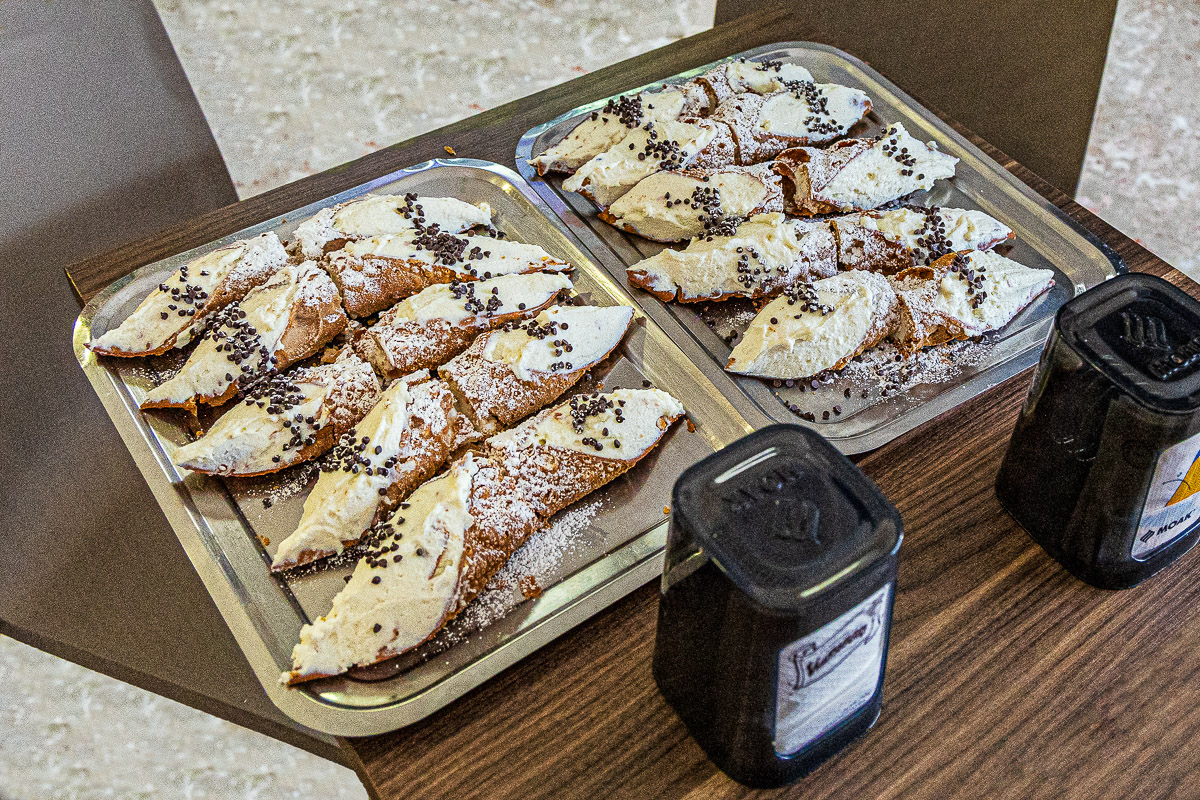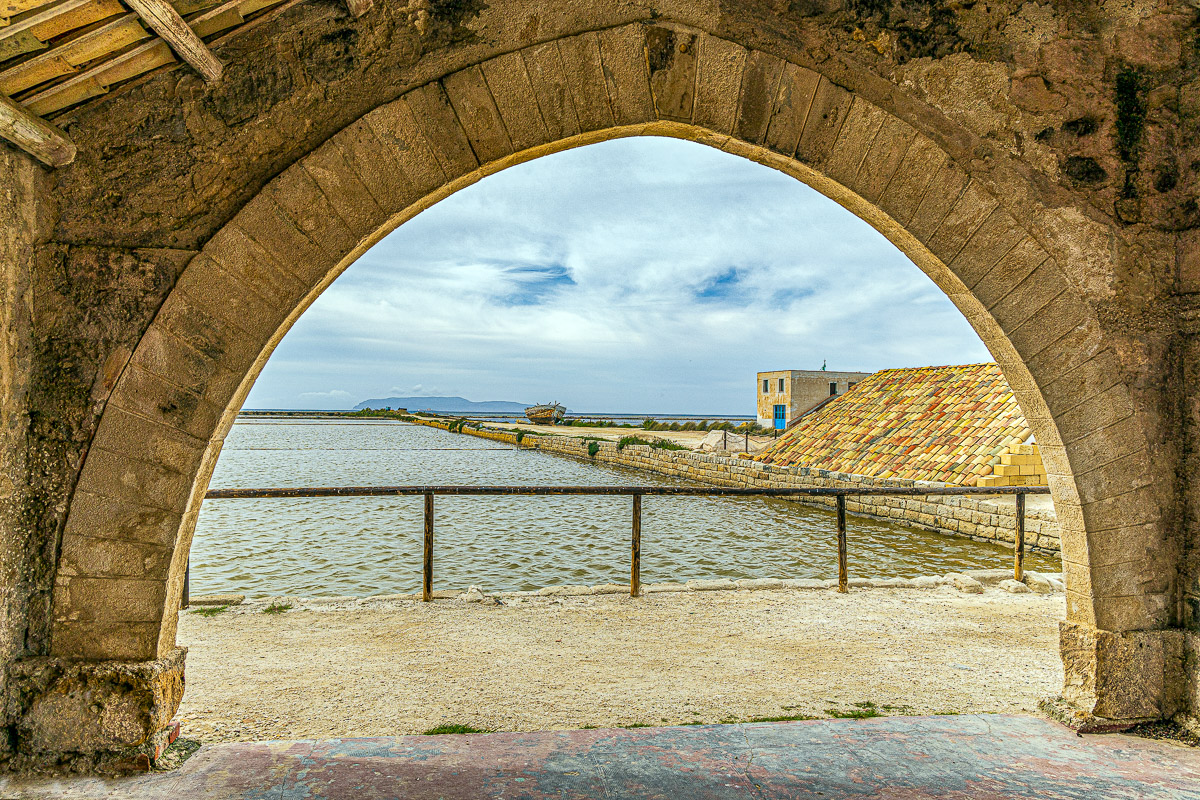It’s about 73 miles by road from Palermo to Erice (EH-ree-cheh), but some of it’s a hilly winding road so it takes about a couple of hours to drive there. That’s long enough to make a rest stop along the way worthwhile. When the bus stopped and we walked into the Bar Vultaggio Specialità in Fulgatore, we realized that this was not a typical rest stop. According to the folks at MyGuideSicily, “the highlight of this bar is the pastry! A must-try are their enormous cannoli: light ricotta cheese in a crispy wafer, topped with chocolate chips.” They were indeed enormous and try them we did!

There’s about a 2,400 foot elevation gain from Palermo to Erice, much of it in the final stretch of the drive. Nearing our destination, we could see the town sitting atop a mountain overlooking the sea. Rick Steves describes it as “an ancient village often cloaked in sea mist.” That is an apt description since, at 10 AM on an otherwise mostly-sunny day, a thin bank of clouds appeared to be nestled gently over the town.
After the bus parked, we entered Erice through the western gate, Porta Trapani, and began our somewhat-uphill walk into town. As usual, I found the narrow, not-quite straight streets interesting. The patterns in the layout of the cobblestones really added a nice design touch. They were not the simple rows of blocks often seen on cobblestone streets. Fortunately, they still had that bumpy, uneven, somewhat inebriated feel that you can enjoy on any cobblestone street.
Mouse over the small photos in galleries to see captions.
Click on any one to enlarge, then use arrows to scroll through the rest of the images.
It wasn’t long before those cobblestone streets took us to a church, the Chiesa Madre, or Mother Church. This church was quite plain looking from the outside and, unfortunately for the Chiesa Madre, the churches we visited the previous day were very hard acts to follow. But it was still pretty inside and worth a brief visit.
Then we wandered around the village looking at the stores and homes, and enjoying scenic views from this mountain top location. Although most of the streets were occupied only by pedestrians, an occasional car did come by. Even though the cars were compact compared to most American cars, the streets were even more so! As a result, it’s important to move to the side, press yourself up against a wall, and hope that your toes don’t get run over.
Ceramics on the storefronts were very colorful and pastries in the bakeries were mouth watering. If I had been in the market for a new suit, I could have replaced herringbone with armor. A “Happy Hour” sign made me wonder if that was an Italian phrase. In one location the Madonna looked down quietly at the street below. Further down a storefront was covered with many colorful woven items that I’m guessing are rugs, table runners and place mats. I thought Erice was rather late in taking down its Christmas tree, but it turned out that they were actually setting up an Easter tree! That holiday was only one week away. We then walked over to the Castle of Venus, which was built in the 7th century BCE. From there we could see Sicily spread out below us with the Tyrrhenian Sea in the distance.
Returning to the bus, we traveled back down the mountain. Our goal was to get as close to sea level as possible without getting our feet wet. Our destination was the extensive Salt Flats of Trapani and Paseco. This area is ideal for salt harvesting because the climate tends to be both breezy and sunny, and the lagoons are shallow with clay-lined beds. I suspect we all know that salt was once a very precious commodity used to preserve meat and fish. The Phoenicians are thought to have been the first to begin harvesting salt here in the eighth century BCE. These salt flats remained an important commodity into the early 20th century when mined rock salt became widely available.
Windmills around the flats made it look like we were in the Netherlands. They were once used to pump water into and between the different salt pans for the various stages of evaporation. Salt harvesting continues in this area, but it was too early in the year for us to observe the process. However, we visited the Saline Calcasi Museum of Salt where the history of the area and the harvesting process were explained. This museum sits under one of the old windmills so the huge gears that used to run the pumps were visible overhead.
To protect the reputation of this salt, in 2011 the European Commission added the name “Sale Marino di Trapani” to its list of Protected Geographical Indications. To use this name, salt needs to be produced in the area between Trapani and Marsala as per tradition, with no additives, bleaching or anti-caking agents.

As we left the salt flats we learned that this area is now part of the Natural Reserve Saline of Trapani and Paceco, which is overseen by the World Wildlife Fund. The area is an important coastal wetland and is home to many migratory birds. We could see flamingos and other birds from the bus, but sadly the bus did not stop and the gravel road was too bumpy for nonblurry photos.
Then we sat back and had a relaxing return ride to Palermo.
<— Churches and more Churches (Sicily Part 10) :: (Sicily Part 12) Food for the Body, Food for the Soul —>